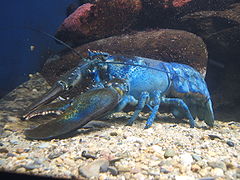Crustacyanin
Jump to navigation
Jump to search

Crustacyanin is a carotenoprotein biological pigment found in the exoskeleton of lobsters and blue crabs and responsible for their blue colour.[1] β-Crustacyanin (β-CR), is composed of two stacked astaxanthin carotenoids that absorb at λ = 580–590 nm (2.10–2.14 eV).[2] α-crustacyanin (α-CR) is an assembly of eight β-CR protein dimers. It is a 320 kDa (atomic mass) complex containing 16 astaxanthin molecules.[3] Although the β-CR dimer has a peak wavelength of 580 nm, α-CR exhibits a bathochromic shift to 632 nm; the mechanism and function of the additional wavelength shift is not understood.[3]
References
- ^ Quarmby, R., Nordens, D.A., Zagalsky, P.F., Ceccaldi, H.J. and Daumas, R. (1977). "Studies on the quaternary structure of the lobster exoskeleton carotenoprotein, crustacyanin". Comparative Biochemistry and Physiology B. 56 (1): 55–61. doi:10.1016/0305-0491(77)90222-x. PMID 830471.
{{cite journal}}: CS1 maint: multiple names: authors list (link) - ^ Gamiz‐Hernandez, A.P., Angelova, I.N., Send, R., Sundholm, D., and Kaila, V.R. (2015). "Protein‐induced color shift of carotenoids in β‐Crustacyanin". Angewandte Chemie International Edition. 54 (39): 11564–11566. doi:10.1002/anie.201501609. PMID 26220698.
{{cite journal}}: CS1 maint: multiple names: authors list (link) - ^ a b Rhys, N.H., Wang, M.C., Jowitt, T.A., Helliwell, J.R., Grossmann, J.G. and Baldock, C. (2011). "Deriving the ultrastructure of α-crustacyanin using lower-resolution structural and biophysical methods". Journal of Synchrotron Radiation. 18 (1): 79–83. doi:10.1107/s0909049510034977. PMC 3004261. PMID 21169698.
{{cite journal}}: CS1 maint: multiple names: authors list (link)